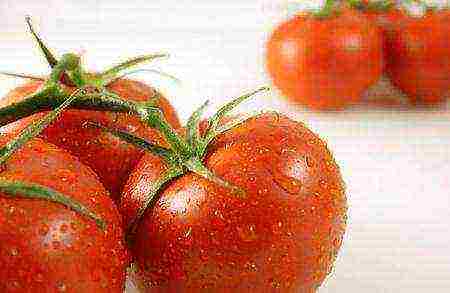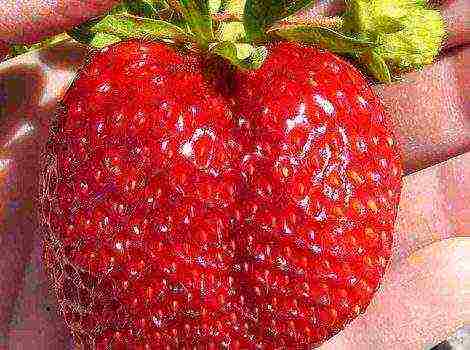Content
- 1 Early varieties of apricot
- 2 Late varieties of apricot
- 3 Winter hardy varieties of apricot
- 4 Apricot varieties for the Moscow region and the middle lane
- 5 The best early varieties of apricots
- 6 The best medium varieties of apricots
- 7 The best late varieties of apricots
- 8 Black apricot varieties.
- 9 Columnar varieties of apricot
- 10 Early maturing apricot varieties
- 11 Apricots with a medium ripening period
- 12 Late ripening apricots
Apricot is one of the most delicious and healthy fruits. Now it is impossible to imagine a single summer cottage on which an apricot tree would not be grown. Previously, the apricot could only be grown in the southern regions, however, thanks to breeders, now the apricot can be grown in various climatic conditions.
Nowadays, there are many different varieties of apricot. In this article, we will look at the most popular apricot varieties and find out which varieties of apricot are ripening.
By the timing of ripening, apricots are:
- early
- mid-season
- late
Early varieties of apricot
Early apricot varieties include the following apricot varieties: Early apricot, Alyosha, Voronezh early, Veteran of Sevastopol, June early and others. Consider the 2 most popular early apricot varieties.
Early apricot
Early apricot is an early apricot variety. Ripening of apricots occurs in mid to late June. This variety belongs to large-fruited varieties of apricots. The tree is vigorous, the fruits are yellow with pink. The pulp is yellow. The variety has a pleasant aroma and sweet taste.
Alyosha
Apricot variety "Alyosha" also belongs to early apricot varieties. Fruits are bright yellow "dotted", rounded shape, flattened on the sides. The fruits are distinguished by a certain brilliance. Fruit weight about 20 g. Orange pulp. The taste is sweet and sour. The tree has a spreading crown, the height of the tree can reach 4 m.
This variety has a high yield and winter hardiness. "Alyosha" is used to make stewed fruit and preserves, and is also used fresh.
Mid-season apricot varieties
The following varieties can be attributed to mid-season apricot varieties: Polessky large-fruited, Nadezhny, Michurinets, Krasnoshchekiy, Dessertny and others. Consider in more detail 2 varieties of mid-season apricots.
Red-cheeked
The red-cheeked variety belongs to mid-season apricot varieties. Fruit ripeness occurs in mid-late July. The apricot tree is tall. The fruits are large (about 50 g), golden orange in color. The fruits have a wonderful aroma, sweet and juicy taste. The skin of the apricot is thin, velvety.
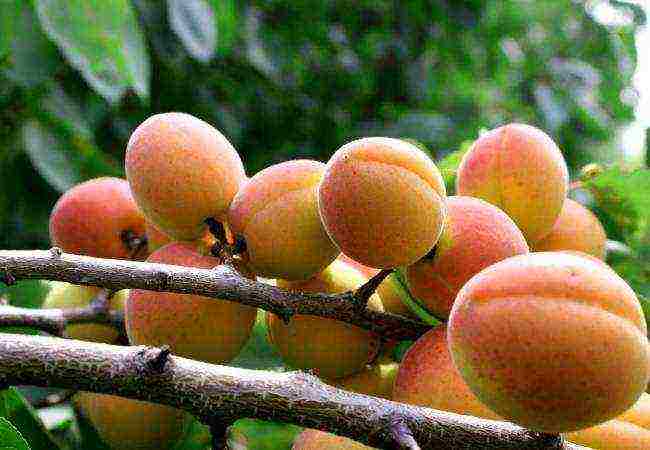
The tree will begin to bear fruit 3-4 years after planting. This apricot variety has excellent winter and drought resistance.
Dessert
The dessert variety also belongs to mid-season apricot varieties. Fruit ripeness occurs in mid-June. The tree has a lush crown and is tall (4-5 m). Fruits are medium rather than large (about 30 g), light yellow in color. The taste is sweet and sour. The skin is thin, the flesh is tender. The variety has good winter hardiness.
Late varieties of apricot
Late varieties of apricot include the following varieties: Ogonyok, Gift, Surprise, Joy, Hardy, Favorite, Honey and others. Consider a couple of late apricot varieties in more detail.
Favorite
The favorite belongs to the late varieties of apricot. The tree is moderately vigorous (height about 3-4 m). The fruits ripen by the end of August, however, even in September, you can see unripe apricots. Fruits are medium-sized, fruit weight is 30 g. Fruits are orange with a bright blush. The pulp is firm, bright orange. The favorite has a delicate, juicy taste.
The favorite is distinguished by good yield, winter and frost resistance. This variety is consumed fresh, canned.
Honey
The honey variety also belongs to the late apricot varieties. A tree with a wide crown, it can reach 4 m. Fruits do not differ in large size, the fruit weight is about 15 g. The color of the fruit is yellow, with a small number of red dots. The flesh of the fruit is also yellow. The fruit has a wonderful aroma and sweet, juicy taste. The variety has an excellent yield and good frost resistance.
In addition to the above varieties of apricot, there are also varieties that are not afraid of frost and winter, I propose to learn a little about them.
Winter hardy varieties of apricot
The following varieties can be attributed to the winter-hardy varieties of apricot: Snegirek, Lyubimy, Vystolivy, Kichiginsky, Piquant, Manchurian, Northern Triumph and others. Consider the 2 most popular varieties.
Manchurian
The Manchurian apricot variety is distinguished by its frost resistance and durability. This variety is able to withstand temperatures as low as -30 degrees. The Manchu apricot tree is especially beautiful during the flowering period. The tree can reach 10-15 m. The fruits are not large (15-20 g), the fruits do not differ in sweetness, they are rather even sour. This variety is more often used for conservation than fresh.
Northern triumph
The Northern Triumph also belongs to the winter-hardy varieties of apricot. This variety not only perfectly tolerates severe winters and spring frosts, but also gives a good harvest. Triumph of the North is resistant to diseases and pests. Apricot trees are not tall.
Fruits are medium-sized (about 40-60 g), oblong-oval, may be asymmetrical. The fruits ripen in early to mid-August. The color is orange with pink. The pulp is yellow, juicy. Apricot has a pleasant aroma and a great sweet taste.
Tatiana Kuzmenko, member of the editorial board Sobcor of the Internet edition “AtmAgro. Agroindustrial Bulletin "
1. Varieties of apricots for the Moscow region and the middle zone.
2. The best early varieties of apricots.
3. Medium varieties of apricots.
4. Late varieties.
5. Varieties of black apricots.
6. Columnar varieties of apricots.
Apricot varieties for the Moscow region and the middle lane
Apricot is traditionally a southern crop, but thanks to the efforts of domestic breeders, it is successfully grown in the difficult climatic conditions of the Moscow region and the middle zone. It is worth purchasing apricot varieties zoned for these places, which have high winter hardiness and self-fertility, as well as the ability to survive possible thaws and spring frosts without much loss. We offer an overview of the most popular types of apricots.
"Lel"
"Lel" is a variety with a very early ripening of fruits, is self-fertile. The yield is small, but if other types of apricots are grown in the neighborhood, the harvest will increase.
- Average yields are about 20 kg per tree.
- Orange fruits weighing 20 gr. excellent taste with easily separable pits.Ripening time - the end of July.
- Spreading trees up to 3 m in height.
- Gives the first harvests in the third or fourth year after planting the seedling.
- It perfectly tolerates frosts down to -30. Suitable for growing in the Central region.
- The susceptibility to diseases and pests is average.
Varietal advantages: excellent taste characteristics of fruits, early maturity, good transportability, decent winter hardiness of the bark and buds.
Minuses: small fruit size, large stone, can be damaged by clasterosporia and aphids without preventive measures.
"Tsarsky"
"Tsarskiy" is an early maturing, self-fertile species, brings stable, but small yields.
- Average yields are 20-30 kg per tree.
- Fruits are yellow with a ruddy barrel weighing up to 20 g with sweet and sour juicy pulp, ripen in early August.
- The tree is moderately vigorous 3-4 m.
- In the third or fourth year after planting, the seedlings begin to bear fruit.
- Strong winter hardiness (up to -40). It is successfully grown in the Moscow region and the middle lane.
- Good resistance to major diseases, it needs protection from pests.
Varietal advantages: early maturing, self-fertile, highly winter-resistant.
Minuses: small in size fruits, low yield, the stone is poorly separated from the pulp.
"Aquarius"
"Aquarius" is a high-yielding, self-fertile, mid-season apricot variety.
- Productivity is regular high 50-60 kg per tree.
- Fruits, yellow with a blush, weighing 25-30 g with tender juicy pulp, ripen in mid-August.
- The tree grows up to 5-6 m in height.
- Begins to bear fruit in the third or fourth year.
- Excellent frost resistance. The variety is zoned for planting in the Central region.
- Resistance to diseases and pests is satisfactory.
Varietal advantages: high-yielding, self-fertile, frost-resistant, easy separation of the bone from the pulp.
Minuses: large tree growth complicates maintenance and harvesting.
"Russian"
"Rossiyanin" is remarkable for its early ripening of fruits and high yield.
- The yields are plentiful up to 80 kg per tree.
- Yellow-orange fruits weighing 50-60 g with tasty juicy pulp. Ripening time - the end of July.
- The tree is 3-4 m high.
- The first crop can be obtained in the fifth year of growth.
- Winter hardy, withstands frosts down to -30. Suitable for growing in the suburbs and regions of the middle lane.
- Susceptibility to diseases is average.
Varietal advantages: early ripening, abundant harvests, large fruits, high winter hardiness.
Minuses: average disease resistance.
"Hardy"
"Hardy" - has a very good winter hardiness of wood and buds. The species is self-fertile, fruitful.
- The yield is 60 kg per tree.
- Fruits, orange with a reddish side, weighing 40 g with aromatic sweet pulp. The harvest ripens in the first half of August.
- The trees are vigorous, 5 m tall.
- It brings the first harvests in the fifth or sixth year after planting the seedling.
- It tolerates severe frosts. It is successfully grown in the Moscow region and central Russia.
- Disease resistance is satisfactory.
Varietal advantages: excellent winter hardiness, stable high yields, self-fertility.
Minuses: the tallness of the tree makes it difficult to care for and harvest.
"Honey"
Apricot "Honey" has high frost resistance, good yield, but self-fruitless and needs neighbors-pollinators.
- It brings yields of 15-20 kg per tree.
- Fruits are golden-yellow with reddish specks weighing 15 g with delicate sweet pulp, ripen in the first half of August.
- Spreading tree with a height of about 4 m.
- First fruiting in the third or fourth year.
- Calmly withstands frosts down to -35 and above. Suitable for planting in the suburbs and central Russia.
- Disease and pest resistance is low. Needs protective measures.
Varietal advantages: high winter hardiness, early maturity, excellent fruit taste, easy separation of the seed.
Minuses: small fruits, self-fertility, low resistance to diseases and pests.
The best early varieties of apricots
"Northern Triumph"
Early ripening variety, self-fertile with excellent yield and winter hardiness.
- The yield reaches 60 kg / s tree.
- Fruits are yellow-orange, weighing 50 g with delicate sweet pulp. Ripens in early August.
- Spreading tree with a height of 4 m.
- Begins fruiting in the fifth year of growth.
- Winter hardiness is excellent. It can be grown in the Central Black Earth Zone, in Siberia, in the Urals.
- High resistance to major diseases.
Varietal advantages: fruitful, self-fertile, early maturing, frost-resistant.
Minuses: fruiting is unstable, average winter hardiness of the buds.
"Khabarovsk"
"Khabarovskiy" is a variety of apricot with early ripening, stable yield and self-fertility.
- Annual yields are high 35 kg per tree.
- Light yellow with a slight blush, fruits weighing 30 g with dense sweet and sour pulp, ripen at the end of July.
- Spreading tall tree 4-5 m.
- In the fourth or fifth year, the tree gives its first harvest.
- Winter hardiness at an average level. The variety is recommended for the Primorsky and Khabarovsk Territories.
- Relatively resistant to major diseases.
Varietal advantages: early maturing, self-fertile, large tasty fruits, high yield.
Minuses: average winter hardiness, low transportability, can be damaged by the moth.
"Pineapple"
The Pineapple variety is characterized by self-fertility and high productivity.
- Yields are 50 kg, and sometimes up to 120 kg in good years.
- Fruits are yellow, large, weighing 35-45 g with aromatic sweet pulp. Ripening time is the second half of July.
- A tree of medium height up to 4 m with a dense crown.
- Fruiting begins in the third or fourth year after planting the seedling.
- Small winter hardiness (up to -25). It is grown in areas with a warm temperate climate.
- Good disease resistance.
Varietal advantages: self-pollinated, high-yielding, drought-resistant, tasty fruit for universal use.
Minuses: average frost resistance, when ripe, apricots quickly crumble from the branches, if you delay harvesting.
"Champion of the North"
“Champion of the North” is an early ripening variety that gives good yields and is self-fertile.
- The yield is 18-25 kg per tree.
- Fruits are orange with a blush, weighing 30-60 g with sweet and sour pulp and easily separable stone. The kernel is sweet at the stone. Ripening time - end of July.
- Strong growth tree with sparse crown.
- In the fourth year after planting, it brings the first harvest.
- High winter hardiness makes it possible to successfully grow this species in the Central Black Earth Region.
- Disease and pest resistance is good, but preventive measures are needed to protect them.
Varietal advantages: high frost resistance, self-fertility, early maturity, good transportability.
Minuses: insufficiently juicy pulp, susceptibility to clasterosporium disease in rainy summers.
The best medium varieties of apricots
"Red-cheeked"
"Red-cheeked" - one of the most common varieties of apricot, unpretentious, fruitful and self-fertile.
- Brings bountiful harvests up to 90 kg per tree.
- Fruits are orange with a bright blush, weighing 40-50 g with aromatic sweet and sour pulp. The bone is easily separated.
- A tree up to 4 m tall with a spreading crown.
- The first crop is harvested in the third or fourth year after planting the seedling.
- Winter hardiness is satisfactory. Recommended for planting in the North Caucasus and Lower Volga regions.
- Disease resistance is relative.
Varietal advantages: self-pollinated, fast-growing, high-yielding, large fruits of excellent taste.
Minuses: when overripe, apricots quickly crumble, needs protective measures against diseases.
"Son of the Red-cheeked"
"Son of the Red-cheeked" - self-pollinated, mid-season, giving good yields.
- Harvest weight 30 kg per tree.
- Fruits are orange with a thick blush, weighing 35-55 g, sweet and sour, juicy, ripen at the end of July.
- The tree is tall with a dense crown.
- The first harvest is obtained in the fourth year.
- Frost resistance is good enough. It is grown successfully in the Lower Volga region.
- Disease resistance is good, but prevention is needed.
Varietal advantages: self-fertile, late flowering avoids freezing by recurrent frosts, fruits of excellent taste with easily detachable pits.
Minuses: poorly tolerates thaws, after which the fruit buds freeze, the thickened crown needs annual thinning.
"Kichiginsky"
"Kichiginsky" is a frost-resistant, mid-season, self-fertile species. For cross-pollination on the site, you need to plant other varieties of apricots.
- The yield is 15 kg per tree.
- Small yellow fruits weighing 15 g with aromatic sweet and sour pulp, easily separated by a stone. The ripening time is the first half of August.
- A tree of moderate growth with a thin crown.
- The beginning of fruiting in the fifth year after planting.
- It tolerates severe frosts perfectly. "Kichiginsky" is recommended for cultivation in the Ural region.
- Immune to major diseases of stone fruit crops.
Varietal advantages: high winter hardiness, stable productivity, good transportability.
Minuses: small fruits, self-infertility.
"Dessert"
"Dessert" is an excellent variety for the middle lane, with early ripening and abundant productivity, self-pollinated.
- Fees from one plant reach 50 kg.
- Fruits are light yellow, weighing 30 g. The pulp is sweet with a pleasant sourness. Fruit ripens at the end of July.
- The apricot tree is about 5 m tall.
- The first fruits are obtained in the fourth year after planting.
- Winter hardiness is high. Recommended for cultivation in the Central Black Earth Region.
- Disease immunity is decent.
Varietal advantages: excellent frost resistance, self-fertility, abundant productivity.
Minuses: a powerful, spreading tree makes it difficult to care for and harvest.
"Countess"
"Countess" is a variety with good winter hardiness and productivity, but needs cross-pollination.
- 20-30 kg of fruits are harvested from the tree.
- Fruits are yellow with a reddish barrel weighing 25 g, juicy and sweet. Harvesting ripe fruits in mid-August.
- Powerful tree 5-6 m high.
- The beginning of fruiting in the third or fourth year after planting the plant.
- Withstands severe frosts up to -30 without noticeable freezing. "Countess" grows well in the Moscow region and the middle lane.
- In a rainy, cold summer, it suffers from fungal diseases, especially damaged by clasterosporiosis.
Varietal advantages: excellent winter hardiness and productivity, excellent taste and keeping quality of fruits, early maturity.
Minuses: self-fertile, very tall tree makes it difficult to care for and pick fruit.
The best late varieties of apricots
"Monastyrsky"
"Monastyrskiy" is a late-ripening, self-pollinated, frost-resistant variety.
- The yield is 20-25 kg per plant.
- Orange apricots with a reddish barrel weighing 30-40 g. Taste sweet and sour, juicy pulp. Ripening time is the second half of August.
- The tree is tall, spreading, 5 m in height.
- Begins to bear fruit in the fifth year after planting.
- It perfectly tolerates the frosty winters of the Moscow region. Recommended for growing in areas of the middle lane.
- Immunity to diseases and pests is significant.
Varietal advantages: excellent winter hardiness, self-fertility, tasty fruits with good transportability.
Minuses: tall trees, due to late ripening in cold summer, the fruits do not have time to ripen.
"Favorite"
"Favorite" is a late-ripening type of apricot, self-pollinated, with excellent winter hardiness, giving stable good yields.
- The collection of fruits is about 20 kg.
- Orange apricots with a thick blush weighing 30 g sweet and sour taste. Fruit picking in the second half of August.
- A tree 3-4 m high with a wide crown.
- It begins to bear fruit in the third or fourth year.
- High resistance to severe frost. It is successfully grown in the Central Region.
- Diseases are slightly damaged.
Varietal advantages: self-fertile, winter-hardy, early-growing, tasty fruits of universal use, the bone is well separated from the pulp.
Minuses: late ripening, in cold summer the fruits do not have time to ripen.
Black apricot varieties.
Black apricot is a hybrid of cherry plum and apricot. This variety has several advantages: late flowering helps to avoid damage to flower buds by spring frosts, trees of moderate growth, high resistance to fungal diseases of stone fruits. Bred varieties of black apricot with high winter hardiness and self-fertility.
"Black Velvet"
"Black Velvet" is a variety of black apricot with an annual yield and high winter hardiness. The variety is partially self-fertile. Cherry plum or other varieties of apricot are suitable for cross-pollination.
- The yield is average, but regular.
- Fruits are dark purple weighing 25-30 g with aromatic sweet and sour pulp. The bone is well separated. Ripening time - the end of July.
- The tree is medium-sized with a neat crown.
- Begins to bear fruit in the fourth year.
- Frost resistance is satisfactory. "Black Velvet" is zoned for the North Caucasian region.
- Practically immune to fungal diseases.
Varietal advantages: frost-resistant, annual yield, good transportability and keeping quality of apricots, excellent disease resistance.
Minuses: small fruit size, partially self-pollinated.
"Black Prince"
"Black Prince" is a type of black apricot with an annual yield, large fruits. Is self-fertile.
- The average yield is 10-15 kg, in favorable years up to 30 kg per tree.
- Fruits are dark-burgundy weighing 60-80 g with tasty juicy pulp. Ripening time - the first half of August.
- The tree is medium-sized 3-4 m with a neat crown.
- Winter hardiness is good, fruit buds are not damaged by spring frosts. Recommended for planting in the North Caucasus region.
- Has a high resistance to major fungal diseases.
Varietal advantages: large-fruited, stable yield, high immunity, self-fertility.
Minuses: poor transportability, when ripe, apricots massively crumble, it is better to collect them unripe.
"Kuban black"
"Kuban Black" is a frost-resistant, medium-yielding, self-fertile variety. Cherry plum and other varieties of apricot are suitable for cross-pollination.
- The yield is average (76 kg / ha) and irregular.
- Burgundy-purple fruits weighing 25-35 g, sweet and sour with a pleasant aroma, ripen at the end of July.
- The tree is tall, the crown is thickened.
- The first harvests can be obtained in the third year after planting the seedling.
- Frost resistance is good enough. "Kuban black" is zoned for the North Caucasian region.
- Excellent disease resistance.
Varietal advantages: winter-hardy, tasty fruits of universal application, good transportability, high immunity.
Minuses: vigorous trees are difficult to care for, self-fertility.
Columnar varieties of apricot
The columnar apricot has a straight, strong trunk with short lateral shoots forming a compact column-shaped crown. Trees of columnar apricot varieties of small growth 2-2.5 m, take up little space and are very decorative. An important point in the cultivation of such species is the annual crown-forming pruning of a young tree as it grows. Columnar apricots are becoming more and more popular with amateur gardeners.
"Prince March"
"Prince March" is a columnar apricot with a good yield, self-fertile and quite winter-hardy.
• Productivity is high enough.
• Apricots are bright orange with a ruddy barrel weighing 30-60 g.The pulp is juicy, sweet with an easily separable bone. Ripening time - early August.
• Low tree 2 m with a columnar crown.
• The first harvest gives in the second or third year after planting the seedling.
• High winter hardiness, tolerates frosts down to -30. It is grown in regions with a warm climate. It is possible to grow in the middle lane with proper care.
• Excellent resistance to diseases and pests.
Varietal advantages: undersized compact tree is easy to care for and when harvesting, self-fertility, early maturity, delicious apricots for universal use.
Minuses: due to early flowering, flower buds can be damaged by spring frosts, requires annual formative pruning.
"Star"
"Zvezdny" is a kind of columnar apricot with excellent winter hardiness and large fruits. The variety is self-pollinated.
- The yield is high.
- Fruits are bright yellow, weighing 40 g, sometimes up to 100 g. The pulp is very tasty and aromatic. Ripening period - the first half of August.
- The tree is not tall with a neat columnar crown.
- It starts bearing fruit in the third year after planting.
- Frost resistance up to -30. It is possible to grow in the middle lane with the necessary care.
- Resistant to major diseases of stone fruit crops.
Varietal advantages: undersized tree, large fruits of universal application, self-fertility and early maturity.
Minuses: obligatory annual pruning, early flowering.
On a note: A common problem when growing apricots is bark heating. Experienced gardeners are advised to purchase seedlings grafted on the stock of frost-resistant, unsupported varieties of cherry plum, plum and thorny plum.
It is best to plant several different varieties of apricot in order to provide yourself with bountiful annual harvests.
Save article to:
Dear visitors of the "Dacha Plot", tireless gardeners, gardeners and flower growers. We offer you to pass the aptitude test and find out whether you can trust the shovel and let you into the garden with it.
Test - "What kind of summer resident I am"
Share this article with your friends:
Apricot is a fruit tree that loves warmth and nutritious soil. Trees can be grown in your garden. You can get a harvest after 4 years of the tree's life. Apricot was brought to the countries of Europe and the CIS from the Caucasus. Today there are dozens of species of this tree, some of which can grow well in a northern climate. When choosing an apricot for your garden, take into account the weather conditions, the climate in the region and the nature of the soil.
If the type of trees is chosen correctly, then every year you will get a rich harvest without significant stress. What are the varieties of apricots, with the name and description, see below.
Apricot varieties can be divided into early, mid-season and late varieties. If you plant several trees in your garden with different periods of fruit ripening, you can get a harvest for almost the entire warm period of the year.
What varieties of apricots can be grown, their characteristics and features, we will consider in this article.
Early maturing apricot varieties
This type of apricot is afraid of frost and is quite sensitive to temperature changes. But, due to their early ripening of fruits, early apricots make it possible to harvest in those regions where the summer is short.
Apricot variety Lel photo
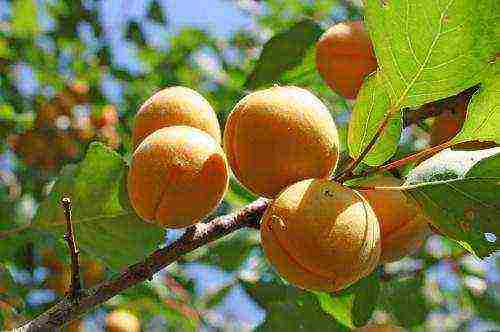
The first harvest can be obtained in the third year after planting the tree. The crown of the apricot is compact, has a neat appearance. The variety can grow up to 3 meters in height. It is practically not susceptible to diseases and gives a stable harvest.
Each fruit on the tree weighs in the region of 20 grams and has a pleasant orange and yellow color. The aroma of the fruit is characteristic of apricots, sometimes the fruit is slightly flattened. The stone is easily removed, the skin is strong. When transported in portioned containers, they practically do not choke.
This variety can be grown for sale, cooking for the family, making jam, or making compote.
Apricot variety Honey photo
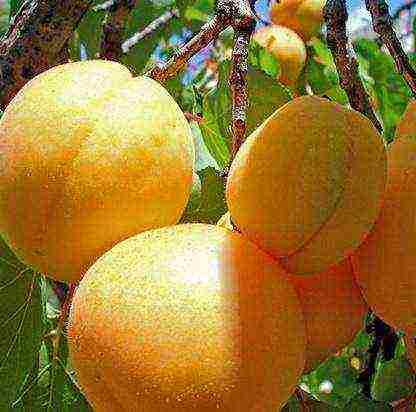
The variety begins to bear fruit after 5 years of life. It has good immunity to diseases, it can survive frost. The fruits have a pleasant aroma and taste characteristic of apricots.
Each fruit has a yellow rind, a small number of red dots are acceptable. Apricot is suitable for freezing, conservation, fresh consumption. The trees do not grow large, it will be easy to care for the garden.
Apricot variety Melitopol early photo
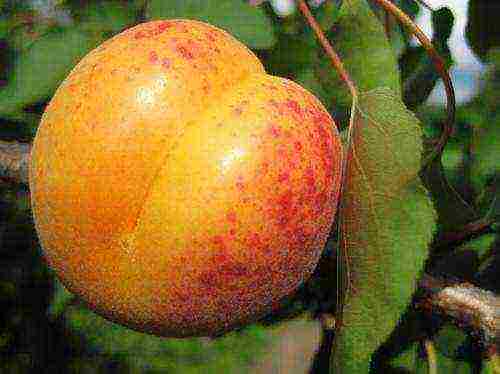
Trees of this variety do not grow large, they give a good harvest. If you distribute the load on the tree, then each fruit can grow up to 60 grams in weight. Apricots have a thin skin and medium sized pits.
It separates normally, the fruits do not have hard fibers. Apricots of this variety are mostly eaten fresh or put up for sale. The variety practically does not get sick. If you do not care about the load on the tree, then each apricot can grow up to 45 grams.
The first harvest can be harvested after 3 years of the tree's life. Melitopol early variety is not afraid of spring frosts, but severe frosts will not benefit it either.
Apricot variety Tsarsky photo
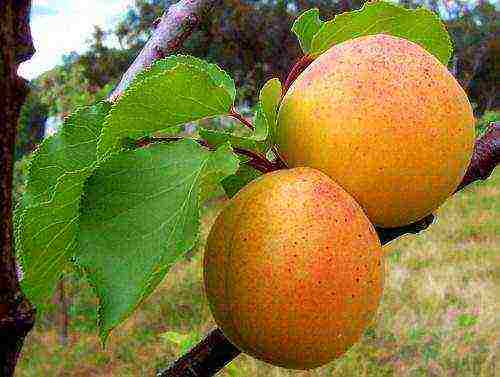
The royal apricot variety begins to ripen only in August. In regions where the summer is short, it is better not to grow it. The tree grows large, its average height is about 4 meters.
The apricot will give birth richly, the average fruit weight is about 23 grams. The fruits have a thick skin, yellow, orange or yellow with a red blush shade. Plucked crops can last up to 14 days if kept cool.
But, for storage, it is worth choosing whole fruits, without dents. If crushed apricots get into the basket, the whole crop can rot. The fruits are used for sale, harvesting for the winter, or fresh food. The Tsar's apricot is resistant to diseases, does not require much attention to itself.
You will receive your first harvest only after 5 years of the tree's life.
Apricot variety Lescore photo
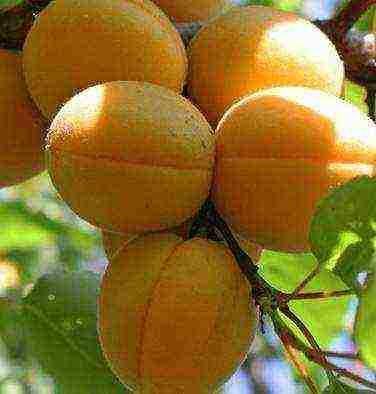
A tree of this variety bears fruit 5 years after planting. The variety is quite resistant to frost, has good immunity against standard diseases of fruit trees.
The fruits grow large, juicy, and there are many of them. The average weight of one fruit can reach 93 grams. The pulp is pleasant to the taste, the skin is of medium density, and the stone is easily separated.
A large type of apricot attracts attention, so the fruits are sold quite quickly. Up to 50 kilograms of harvest can be harvested from one tree. If you plan to sell natural products, it is recommended to have several trees of this variety in your garden.
Medium ripening apricots
Apricots with an average ripening period differ from early varieties in that they are more resistant to unstable temperatures and tolerate the absence of moisture well. The fruits of these trees can be taken for the manufacture of dried fruits, conservation and preparation of desserts. What varieties can be called mid-season, we will consider their characteristics below.
Apricot variety Pineapple photo
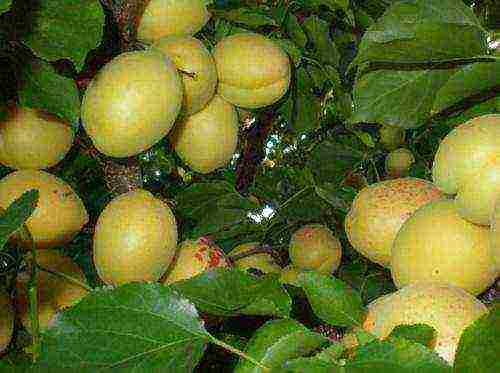
The variety has a good yield. Begins to bear fruit from the age of 5 years and every year the yield grows. When your garden turns 15 years old, you can get up to 155 kilograms of fruit from one tree.
Trees of this variety have good immunity to diseases of fruit crops and relative resistance to frost.
Apricots of this variety have a pleasant aroma, sweet taste and dense skin. Suitable for the preparation of dried fruits, preservation, for sale and consumption as a dessert.
Apricot variety Shalakh photo
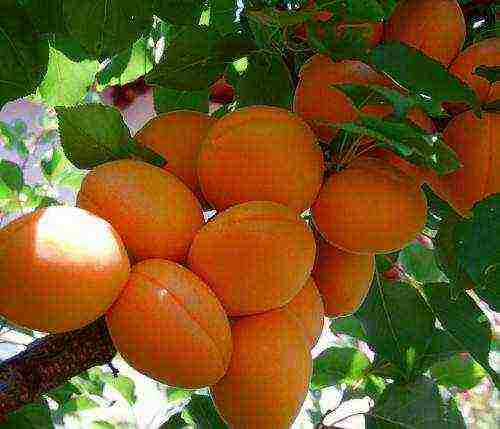
The tree begins to bear fruit in the 4th year of life, grows high upwards. The average lifespan of one tree is about 65 years. Thus, choosing the Shalakh variety, you can grow an orchard for several generations.
Each fruit weighs in the region of 53 grams. The harvest is rich every year.This apricot variety is grown because it is not very whimsical to weather conditions and the type of soil. There is no serious system of caring for fruit trees either.
Trees should be protected from too low temperatures. In frost - 19 degrees, apricot can freeze badly. At the same time, the buds and flowers of the culture perfectly tolerate frosts.
And if at the slightest frost the inflorescences of other varieties die off, then Shalakh will give you a harvest. Trees are resistant to diseases. It is profitable to grow fruit crops in the middle zone of the country.
Apricot variety Russian photo
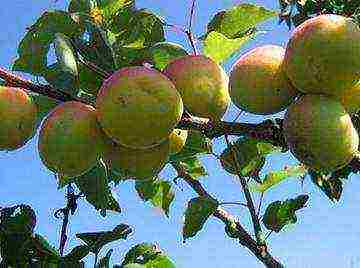
The variety begins to produce crops 5 years after planting or grafting. The fruits grow large, the average weight of one apricot is around 112 grams. The peel is dense, uniform yellow color.
The variety survives frosts normally, practically does not get sick. The fruit crop is perfect for growing in almost any region of the country. Trees do not grow tall, but have a spreading crown.
The crop can be harvested as it ripens, around the end of July.
Apricot variety Saratov ruby photo
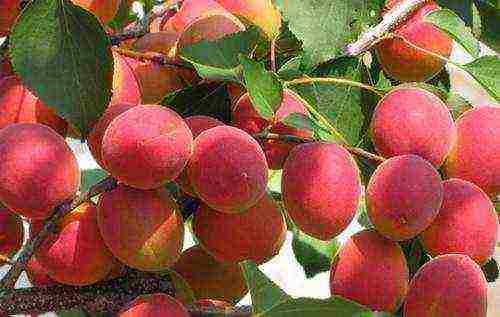
Apricot is suitable for growing in the northern regions of the country and throughout its territory. Calmly tolerates frost at -40 degrees and can bear fruit after that.
Diseases are practically not exposed, but high-quality and timely care is highly desirable. There is always a lot of harvest. Each fruit weighs in the region of 40 grams. The largest fruits on the tree have an average weight of up to 51 grams.
The color is uniform with a ruby blush, which sometimes occupies up to 90% of the fruit area. The skin is firm, the pulp is tasty. Apricots are good for sale, they can survive transportation and keep the juice out.
If you cook compote from apricots or make dried fruits, they will retain their color. In general, the variety is profitable to grow, it can bring a good profit.
Apricot variety Royal photo
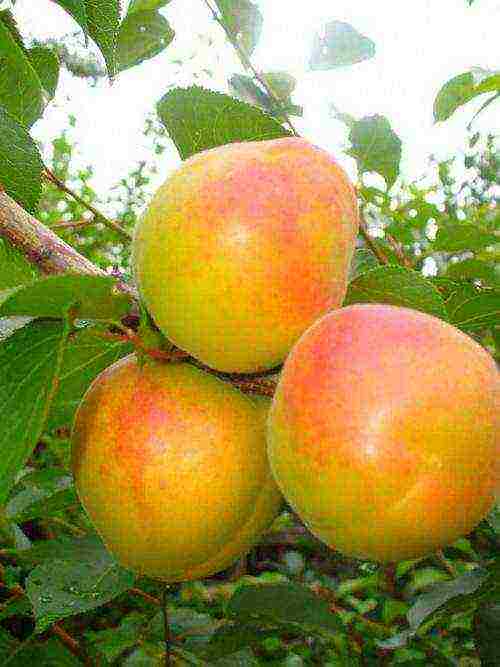
From one tree, you can get up to 156 kilograms of fruit, depending on its age. Culture is not afraid of frost and disease. But, despite this, at a temperature of -20 degrees, it can freeze.
The tree begins to bear fruit in a couple of years after grafting, the harvest is rich. Each fruit weighs in the region of 44 grams, has a dense rind and sweet flesh. Apricots are suitable both for private purposes and for growing for sale.
Apricot variety Triumph northern photo
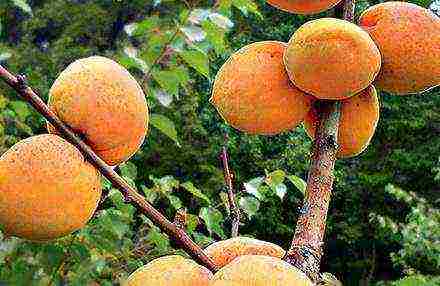
Trees survive frost well, practically do not suffer from diseases. The variety bears fruit 5 years after grafting. There is a possibility that after a couple of years of life, he will become self-fertile.
The average weight of one fruit is around 55 grams. The pulp is sweet, soft and has a characteristic apricot aroma. The fruits are suitable for transportation, sale and preservation preparation.
Apricots can be eaten fresh, but jam and kaisa are especially tasty from them. Apricots ripen in the middle of summer. It is not difficult to grow this variety, if you take time for it, it will delight you with a rich harvest.
Late ripening apricots
The late varieties include those types of apricots that can be stored in the refrigerator for a long time. They are harvested at the end of August, and in the spring the inflorescences do not suffer from frost.
This happens because when late apricots are blooming, the weather is sunny, dry and warm outside the window. What apricots with a late ripening period can be grown, we will consider below.
Apricot variety Pervise photo
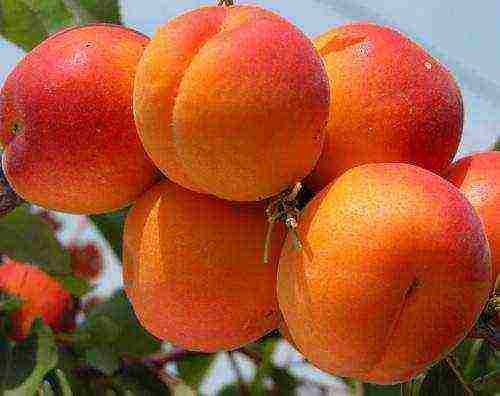
I got to the territory of Russia from Armenia. It survives well, frosts and bears large fruits. Up to 40 kilograms of harvest can be harvested from one tree. The variety is practically not susceptible to diseases.
Dried fruits can be prepared from the fruits of this variety. The finished product can be obtained up to 35% of the total mass of the fruit. If you freeze apricots or make jam from them, the quality will not be very good. This is due to the tough fibers inside the berries.
Apricot variety Canning photo
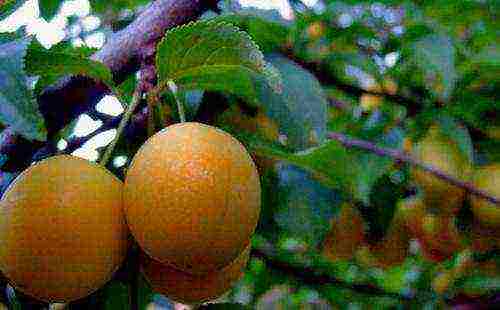
The apricot begins to bear fruit 4 years after planting.The crop gives a lot, the fruits weigh in the region of 50 grams. They taste sweet and sour, have a strong skin.
The trees are not very tall, but they have many branches. The culture tolerates frost and temperature changes perfectly. It matures almost with the last warm days.
Apricots of this type can be grown in regions where there is no severe frost.
Apricot variety Spark photo
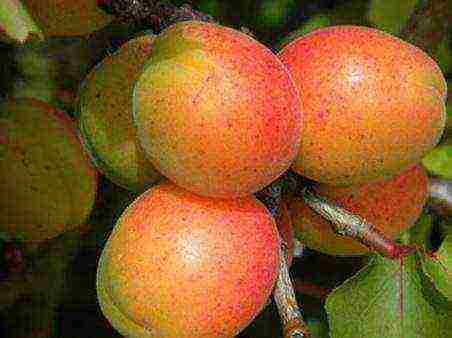
Trees of this variety grow up to 4 meters in height. The growth is even, the crown is large and spreading. Apricot begins to bear fruit after 4 years from the moment of planting.
The fruits grow large, with an average weight of up to 50 grams. The pulp is juicy, crispy, and has a pleasant smell. Reaches the harvest in August and can be perfectly stored in the refrigerator for more than a month.
But, for this you need to choose fruits that do not have damage to the peel and signs of rot. You can eat fresh apricots or prepare dried fruits, preserves, compotes, freezing from them. The tree will calmly survive frost at -36 degrees and will bear fruit after that. There is no serious system of care for this apricot variety. Trees are grown in any region of the country except the Far North.
Apricot variety Melitopol late photo
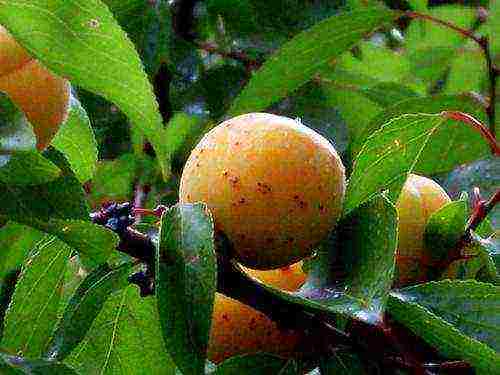
Another apricot variety that can be grown in a region with a cold climate. The tree grows moderately, tolerates sub-zero temperatures well. In spring, its buds and flowers will not freeze during frost.
It has average immunity to diseases. Needs periodic care and prevention of stone fruit cancer. A lot of fruits are obtained, the tree bears fruit abundantly.
The first apricots can be harvested after 3 years of culture life. Apricots grow large, juicy and have a strong peel. Delicious dried fruits and freezing are obtained from these fruits.
You can store apricots in the refrigerator for a while. The average weight of one fruit is about 55 grams, there are no hard fibers inside. It is possible to grow this variety of apricot, both for commercial purposes and for personal consumption.
One of the late varieties of apricots, it has large fruits with a beautiful blush. You will see the first harvest already in the 4th year after planting the trees. It is practically not afraid of frost, it needs minimal care. The average weight of the fetus is around 35 grams. Apricots have the appearance of a ball and look good on the counter. At the end of summer, when there are few natural goodies left, apricots will be sold easily.
This variety can be grown in almost any region of the country. In general, with high-quality and regular care, any apricot variety is capable of producing a good harvest.
Choose tree species that will survive in your area and will not require much attention. Growing apricots is considered a standard part of gardening and is profitable.
 The best varieties of apricots: characteristics and description It is difficult to call the territory where apricots are not grown as a full-fledged summer residence. Therefore, we are urgently considering the best varieties of apricots and planting a classic fruit tree to complement the garden and juicy gifts for children and grandchildren.
The best varieties of apricots: characteristics and description It is difficult to call the territory where apricots are not grown as a full-fledged summer residence. Therefore, we are urgently considering the best varieties of apricots and planting a classic fruit tree to complement the garden and juicy gifts for children and grandchildren.
Content:
-
- The best varieties of apricots
- Early varieties of apricot
- Apricot variety Alyosha
- Apricot variety Melitopol early
- Apricot variety Lescore
- Mid-season varieties of apricots
- Apricot variety Red-cheeked
- Polessky large-fruited - a really large variety of apricot
- Apricot variety Yaltynets
- Apricot variety Pineapple
- Late varieties of apricots
- Apricot variety Favorite
- Apricot variety Iskra
- How to choose the best variety of apricot for a summer residence (video)
We repeat once again, but it is really difficult to imagine a dacha without apricots. This is one of the few trees with which a village, a suburban area, a summer cottage is associated, as well as warmth, sweetness, beauty of fruit and a unique aroma.
Today we decided not to talk about how apricots are grown in the country, but to devote time to choosing the best variety of apricots, because it is worth starting with this, having decided exactly what we want to grow on our own plot.
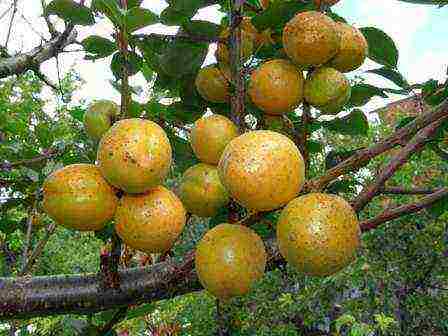 We choose juicy, aromatic, sweet and large varieties of apricots for planting in the country
We choose juicy, aromatic, sweet and large varieties of apricots for planting in the country
The best varieties of apricots
It is difficult to judge these plants in this way, choosing which is better and which is worse, because each apricot has its own unique aroma and taste, fruit density and juiciness, sugar or sourness content.But these are not all the characteristics, especially if we recall the early and late varieties, large fruits, and even the number of lived inside each ripe apricot. In general, it will not work so easy to figure it out, and therefore we suggest that you take the time and study the topic more deeply.
So, we make an easy overview of the varieties so that, based on the results, you can choose apricot varieties for the Moscow region, Ukraine, the Middle Strip, as well as other climatic zones and regions.
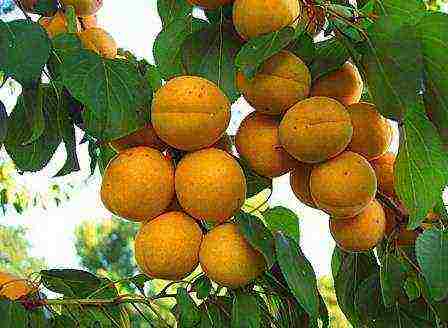 Experts recommend early, mid-season and late apricot varieties for summer cottages
Experts recommend early, mid-season and late apricot varieties for summer cottages
Early varieties of apricot
There are quite a few early varieties, and we will give most of them now, but be careful, because we will talk about some in more detail. It seems to us that they are the ones that deserve the most attention.
By and large, the following early varieties of apricots can be grown in the country: Alyosha, June, Alliance, Lescore, Melitopol early, Sambur early, Tsarsky, Iceberg and others.
Apricot variety Alyosha
An early variety that has become popular for a very long time. The tree of this variety is of medium height, up to 4 m, the crown is spreading and round. The apricot produces medium-sized fruits, 15-20 g each. The fruits are slightly flattened, bright yellow, pubescent, with a dotted pattern and sheen. The flesh of the fruit is quite firm and has a good sweet and sour taste.
The variety has a high yield and good winter hardiness. In addition, high-quality fruits can be stored for a long time, and can be used raw and ready-made (compotes, preserves, jams, etc.).
The cultivation of this variety does not differ from the agricultural technology of other apricots, the only thing that is required from the owners of the dacha with these plantings is to collect the fruits in time so that they do not have time to fall off.
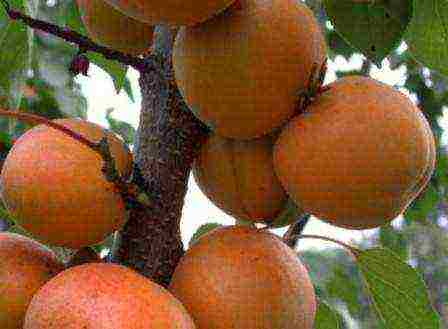 Apricot variety Alyosha - popular and has long been known to many summer residents
Apricot variety Alyosha - popular and has long been known to many summer residents
Apricot variety Melitopol early
This variety is great for almost any summer cottage, because it is resistant to many diseases, as well as high winter hardiness. The variety shows a high growth of a tree with a pyramidal crown, an average yield, serious fruits in size, sometimes up to 50-60 g each. The fruits are oval, slightly flattened, orange-yellow with a thin skin, under which there is a fragrant and dense pulp without fibers. The sweet taste and high quality of the fruit will not leave anyone indifferent as long as there are ripe apricots on the tree.
Melitopol early does not require special care, the main thing is timely pruning in order to prevent thickening of the apricot crown.
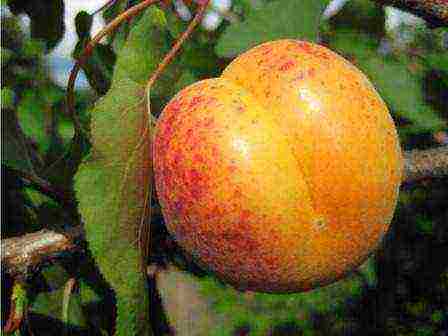 Apricot variety Melitopol early - a great opportunity to taste the fruits in early summer
Apricot variety Melitopol early - a great opportunity to taste the fruits in early summer
Apricot variety Lescore
This variety is practically unknown, since it was not widely advertised by the breeder, whose name was also lost in the archives. The Lescore variety came to us from the Czech Republic, where it has been grown for a long time, since summer residents really like its early maturity.
Lescore is distinguished by a strong, tall tree, the crown of which is reverse-pyramidal, which, by the way, is very interesting. The fruits of the tree are medium-sized, and sometimes large, up to 45 g, have a pleasant taste and a strong, natural aroma. The only drawback of summer residents is the weakness before certain diseases, especially before moniliosis.
It is important to prevent diseases of the tree and treat it with special preparations in time. In the summer, it is imperative to provide watering, about once or twice a month.
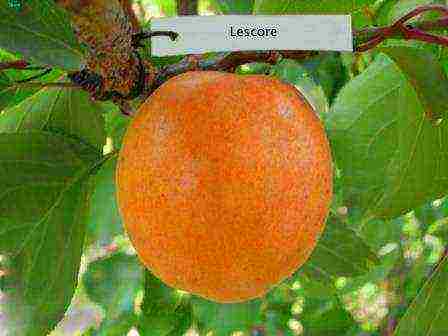 Lescore is a little-known apricot variety that soon promises to become very popular
Lescore is a little-known apricot variety that soon promises to become very popular
Mid-season apricot varieties
Most often, dachas grow medium-ripened apricots, this is even some tradition. Among them are the following varieties: Krasnoshchekiy, Zaporozhets, Goldrich, Altair, Aviator, Petrel, Olympus, Phelps, Polesskiy large-fruited, Aquarius, Yaltinets, Monastyrskiy, Amurskiy, Molodezhny, Shalamark and others.
Apricot variety Red-cheeked
A medium tree and a spreading crown can show excellent results - fruits weighing up to 35 g. Fruits are bright orange, with reddish sides, slightly flattened and similar to an oval. The taste of the fruit is sweet with some sourness. Red-cheeked is a self-fertile variety, and therefore is very popular among summer residents. In addition, the plant shows high productivity, unpretentiousness, average neutrality to diseases, drought and frost.
An unpretentious tree can live in almost any conditions, but only if diseases are not allowed, for which prevention is necessary.
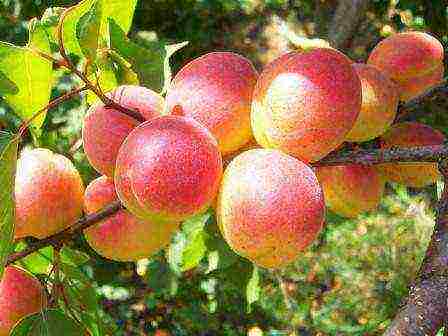 Red-cheeked is an ideal apricot variety that is great for growing in a summer cottage
Red-cheeked is an ideal apricot variety that is great for growing in a summer cottage
Polessky large-fruited - a really large variety of apricot
The trees of this variety are medium-sized, with a rounded crown and very dense greenery. The fruits are sweet and sour, tender, very aromatic, weighing up to 55 g, which is considered an excellent result. The fruit itself is oval or round, bright orange with red sides or blotches, but most often, just ruddy.
The fruits of Polesskiy apricot are excellent for eating raw, but processing into preparations is also possible. Summer compote is especially tasty from apricot.
The variety is considered fruitful and fast-growing, which means it is perfect for a summer cottage where the garden is updated or supplemented.
Large-fruited varieties require timely and accurate harvesting, and therefore be prepared to use a stepladder, tables and chairs. By and large, the tree will not require any serious care, except for the standard apricot agricultural technology.
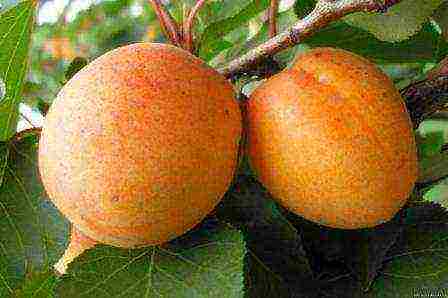 Polessky large-fruited - a fruitful variety for lovers of large and sweet apricots
Polessky large-fruited - a fruitful variety for lovers of large and sweet apricots
Apricot variety Yaltynets
A unique tree with original fruits, strong growth and a spreading crown. The fruits are really large, up to 60-65 g, ovoid, flattened on the sides, most often orange, but there are also bright yellow with a specific shade. Speaking about taste, you can notice a serious difference from many varieties, because the taste is sweet and pronounced.
The fruits of Yalta have excellent canning and table qualities, and therefore can be safely used fresh or ready-made.
The plant is distinguished by a constantly high yield, resistance to drought and frost, as well as good resistance to many diseases of the orchard.
 Apricot variety Yaltynets is a fruitful and large-fruited variety that perfectly resists many diseases of the garden
Apricot variety Yaltynets is a fruitful and large-fruited variety that perfectly resists many diseases of the garden
Apricot variety Pineapple
Medium-sized tree with a rounded crown, which is not distinguished by abundant greenery. The variety is considered to be quite fruitful, sometimes up to 150 kg of fruits from one tree. Pineapple apricots are large or medium-sized, weighing about 40-50 g, orange in color and compressed on both sides. Medium density pulp, excellent taste and aroma.
Pineapple apricot is self-fertile, highly frost-resistant, but susceptible to some garden diseases.
This variety is considered unpretentious, but requires special attention in mass plantings. It is undesirable to shade it with larger trees; timely pruning is required.
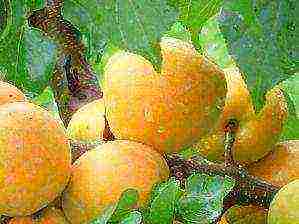 Pineapple apricot - for lovers of exotic and very aromatic fruits
Pineapple apricot - for lovers of exotic and very aromatic fruits
Late varieties of apricots
The late varieties, which ripen closer to the last warm days of summer, include the varieties of apricots: Kievskiy red, Iskra, Favorit, Sirena, Kostyuzhenskiy, Osobenniy Denisyuk and others.
Apricot variety Favorite
The tree is medium-sized, the crown is medium-spread. Fruits are medium in size, weighing about 30 g, beautiful and shiny, orange and slightly pubescent, round in shape. The pulp of the fruit is dense, orange in color, very tasty and juicy, reaching the highest points in tasting competitions.
The fruits of this variety, like, in principle, any other, are excellent for fresh consumption, but also suitable for conservation.The variety shows high winter hardiness, although it also has a serious drawback - in some regions, the fruits do not have time to ripen before the end of the warm season.
It is imperative to prevent diseases and pests that can spoil the tree and deprive you of fragrant and tasty fruits.
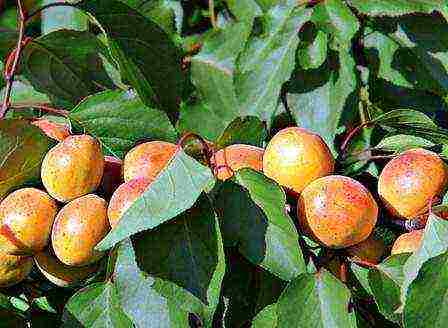 Apricot variety Favorite - the owner of the highest marks at competitions and tastings
Apricot variety Favorite - the owner of the highest marks at competitions and tastings
Apricot variety Iskra
A medium-sized tree with a rounded crown, which begins to bear fruit early enough. The fruits of the variety reach a weight of 45 g, round, sometimes asymmetrical, orange in color with red blotches or a characteristic pink blush. Pulp with sweet and sour taste, medium density, juicy enough.
Speaking about the advantages of the variety, it can be said that Iskra has a constant yield, increased winter hardiness and resistance to some diseases of the orchard.
 Iskra is an apricot variety that shows a high yield of medium-sized and very tasty fruits
Iskra is an apricot variety that shows a high yield of medium-sized and very tasty fruits
Do not forget about pruning and timely spraying of trees, especially when you carry out prophylaxis of the entire orchard.
From the above list, you can easily choose winter-hardy apricot varieties, sweet or sour-sweet, as well as peep large-fruited apricot varieties.
In addition to the varieties that we have already indicated in our material, the apricot varieties Lel, Delight, Triumph northern, Black and Honey apricots, as well as the Kichiginsky variety, are popular with summer residents.
How to choose the best variety of apricot for a summer residence (video)
Choose the best varieties of apricot it is much easier not only when you read some of the characteristics, but also when you thoroughly understand the agricultural technology of growing apricot, because you need to choose a variety according to your own requirements, but do not forget about the needs of the tree itself.
